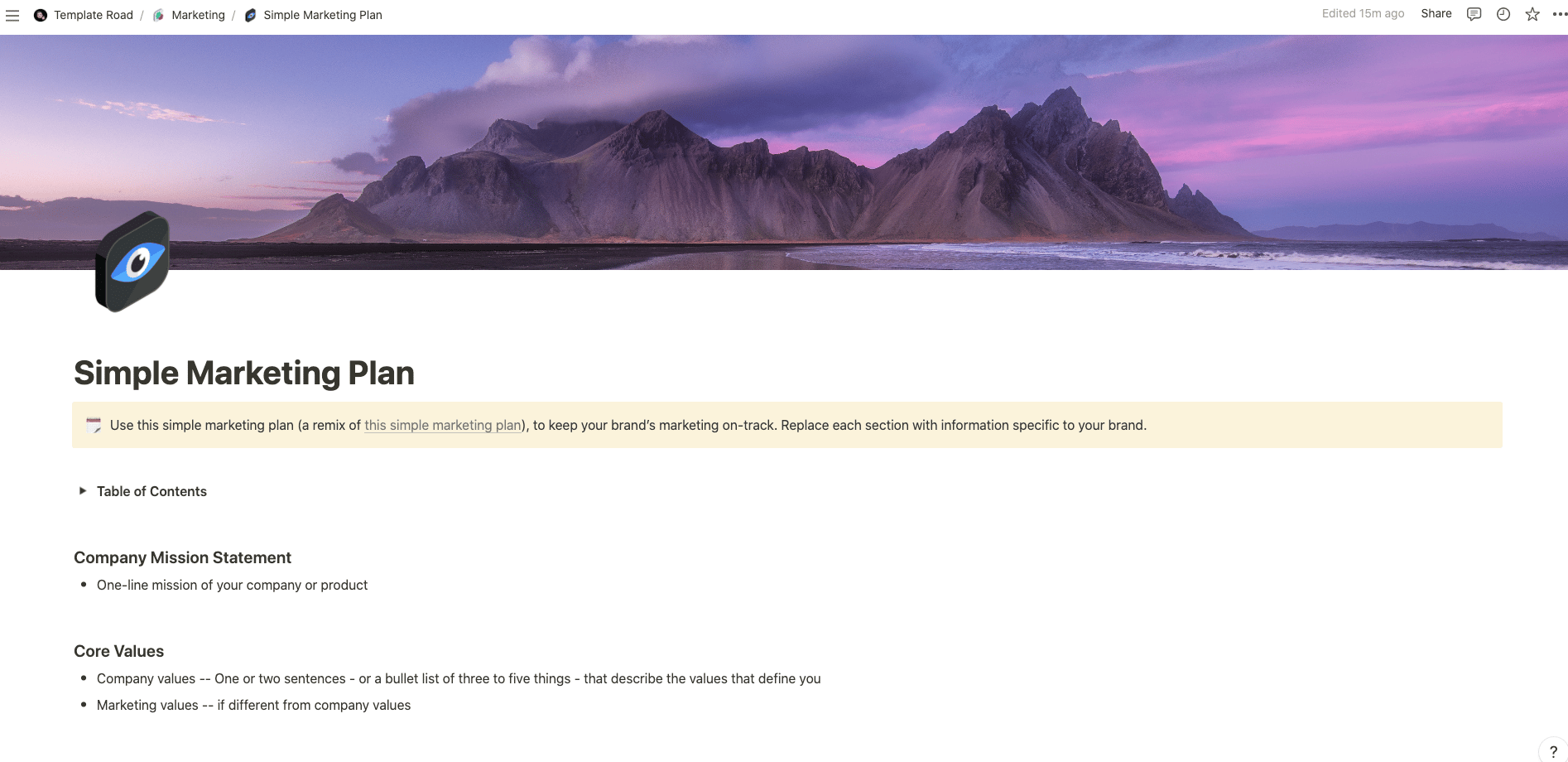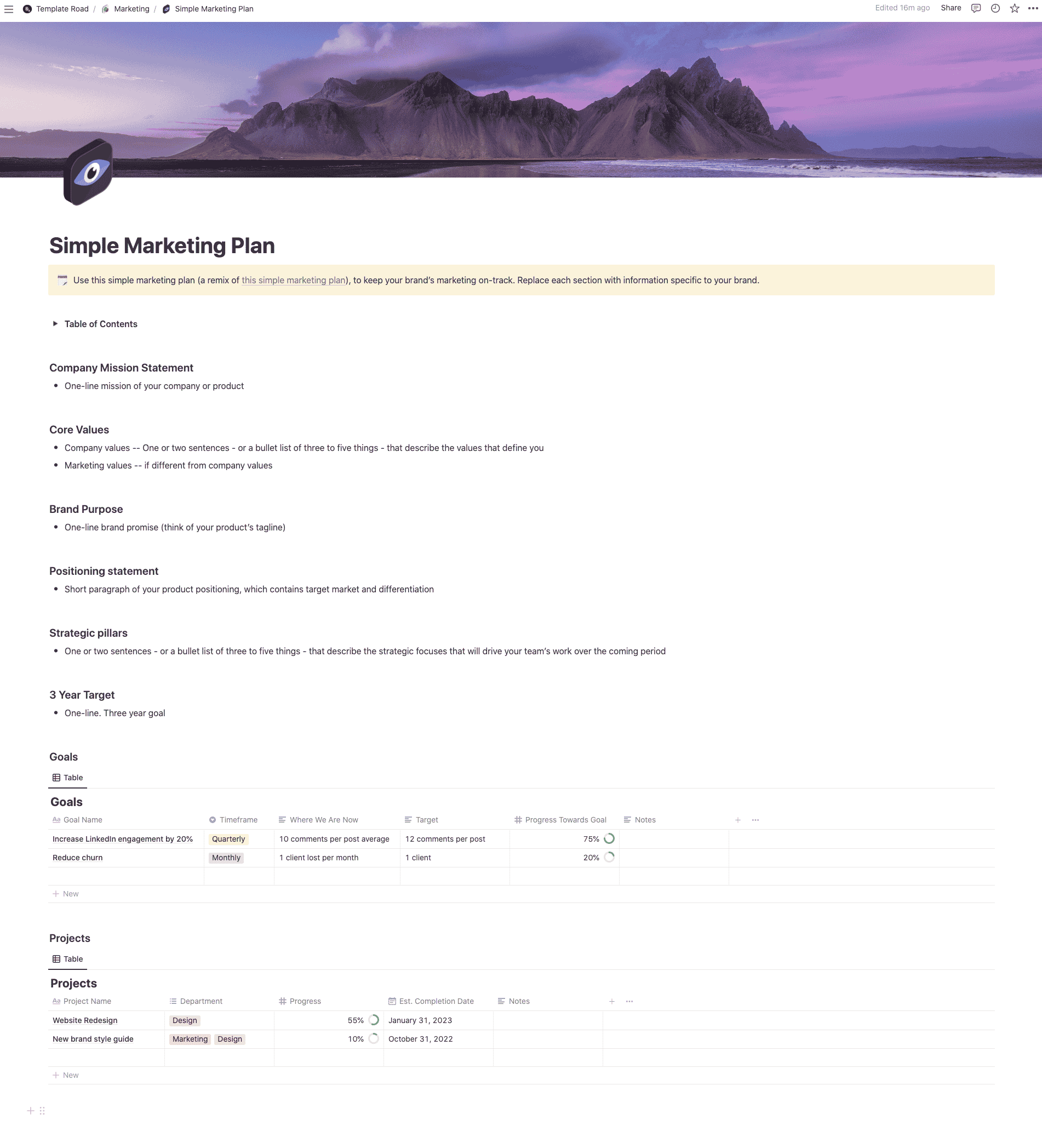Use this simple marketing plan so you can plan out your year ahead, keep your team on track and aim for lofty business goals.
Buy on
Contents
- Notion – Simple Marketing Plan Template
- How To Create A Simple Marketing Plan
- 1. Start With The Basics
- 2. Define Your Goals
- 3. Set Up An Action Plan
- 4. Write Down Everything That Needs To Happen
- 5. Make Sure That All Of These Steps Are In Place By…
- 6. Keep Track Of How You Are Doing
- 7. Review And Adjust As Needed
- 8. Repeat Until Successful
- How to write a company mission statement
- How to determine your company’s core values
- How to write a vision statement
- What is a company’s brand purpose?
- How do you write a positioning statement?
- How to set meaningful company goals
Notion – Simple Marketing Plan Template
Use this simple marketing plan so you can plan out your year ahead, keep your team on track and aim for lofty business goals. A marketing plan is a blueprint for your business that will help you achieve success. It’s not just about writing down what you want to do, but it’s also about how you are going to get there. A marketing plan should be comprehensive and detailed enough so that you can see exactly where you need to go with your business in order to reach your goals.
——————————————-
What you need before purchase
- Basic knowledge of how to use Notion
- Paid Notion account if you’ve looking to add lots of content to your template / Notion account (sign up here). Not much content? You’re able to use their free account.
——————————————-
After purchase
After purchase, you’ll be able to view the template immediately. The template can be added to your Notion account by:
- Click on the template download link in Gumroad
- When viewing the Notion template, click on the “Duplicate” link in the top-right of your screen
- The template will now be available in your own Notion account
For ongoing use, the steps are:
- Login to Notion and select the template you want to view
- Click on the Duplicate link in the top-right of your screen to create a copy to use
- You’ll be able to retain the Notion template and work on the Duplicate (with a new name) and can repeat this process whenever you want to use the template again
If you have never created a marketing plan before, then the below information will provide some great tips on how to start creating one.
How To Create A Simple Marketing Plan
1. Start With The Basics
The first step of any successful marketing plan is to know who your target audience is. You may think that everyone wants to buy from you, but if you don’t know who they are or why they would purchase from you, then you won’t be able to effectively market yourself.
2. Define Your Goals
Once you know who your target audience is, you need to define your goals. If you don’t set clear goals, then you will end up doing things that aren’t working towards reaching those goals. For example, if you want to increase sales by 10%, then you need to make sure that you are focusing all of your efforts on achieving that goal.
3. Set Up An Action Plan
Once you have defined your goals, you need to come up with an action plan to reach them. This means that you need to figure out what steps you need to take in order to reach your goal.
4. Write Down Everything That Needs To Happen
You need to write down everything that needs to happen in order to reach your ultimate goal. This includes:
- Setting up a website
- Writing articles
- Creating social media posts
- Making videos
- Getting press coverage
5. Make Sure That All Of These Steps Are In Place By…
This is the most important part of your marketing plan because it is the only way that you will be able to measure whether or not you are actually getting closer to your goals.
6. Keep Track Of How You Are Doing
It’s easy to lose sight of your goals when you are busy running around trying to meet deadlines. However, if you keep track of how you are doing, then you will be able to see which areas of your business require more attention than others.
7. Review And Adjust As Needed
As time goes on, you will probably find that certain aspects of your business change. For example, if your product line changes, then you will need to adjust your marketing strategy accordingly.
8. Repeat Until Successful
It takes time to build a successful business, so you will need to repeat these steps until you finally reach your goal. Once you do, you will feel like a true entrepreneur!
How to write a company mission statement
A company mission statement is a short document that describes the purpose of your organization. It is usually written at the beginning of a new project or initiative, and it serves as a guide for future decisions. Mission statements are often used in conjunction with other types of documents such as strategic plans and vision statements. They are also useful tools for communicating the values of the organization to its employees and customers.
How to determine your company’s core values
The best place to start when writing a mission statement is to identify your company’s core values. Core values are the fundamental beliefs that drive the actions of your organization. They can include anything from “We believe in honesty” to “We value creativity.” Core values should be communicated throughout the organization, including through employee handbooks and job descriptions. They should also be included in the company’s annual report, which provides information about the company’s financial performance and activities.
How to write a vision statement
Vision statements describe the direction that your company wants to go over the next few years. They provide a sense of where the company is headed, and they help employees understand why their work matters. Vision statements are typically longer than mission statements, but they tend to focus less on specific details and more on broad themes. Vision statements are especially helpful for companies that have been operating for several years. They can serve as a reminder of what made the company great in the past, and they can inspire employees to continue working toward those same goals.
What is a company’s brand purpose?
Branding is the process of creating an identity for a company by developing a set of characteristics that distinguish it from competitors. A good branding campaign helps consumers recognize your products and services, and it makes them want to buy from you instead of someone else. Brand purposes are one of the three main components of a brand identity (the other two being logo design and tagline). Brand purposes are the reasons that people choose to associate themselves with a particular company. For example, Apple Computer has a brand purpose of “designing personal computers,” while Nike has a brand purpose of providing athletic shoes. Your own company may not have a formal brand purpose, but you can still develop one using the following tips:
- Identify your target audience.
- Determine what qualities make up your ideal customer.
- Develop a list of attributes that define your brand.
- Choose a name for your brand.
- Create a logo and tagline.
- Write a mission statement.
- Develop a website.
- Start advertising.
- Conduct market research.
- Evaluate results.
- Make adjustments.
How do you write a positioning statement?
A positioning statement describes how your company fits into the marketplace. It explains who your company is, what it does, and what sets it apart from others in the industry. Positioning statements are usually shorter than mission or vision statements, but they should be just as detailed. Positioning statements are most effective if they are written at the beginning of a business’s life cycle. This allows you to establish your company’s core competencies before you start growing. For example, if you sell software, you might position yourself as a provider of high-quality, easy-to-use applications. If you sell widgets, you could position yourself as a low-cost alternative to traditional manufacturing methods.
Positioning statements are useful when you need to explain your company’s strategy to investors, potential customers, or other stakeholders. They also help you communicate your value proposition to employees.
How to set meaningful company goals
Goals are the milestones that your company plans to achieve during its lifetime. Goals are important because they give your company a clear idea of where it wants to get in the future. They also motivate employees to keep moving forward.
When setting goals, consider these factors:
- What will this goal accomplish?
- Who will benefit from achieving this goal?
- How will you measure success?
- When will you reach this goal?
- Will your company continue to grow once this goal is achieved?
- Are there any risks involved?
- Is this goal attainable?
- Does this goal fit within your overall strategic plan?
- Can you realistically meet this goal?
- Do you have the resources necessary to achieve this goal?
- Have you considered all possible alternatives?
- Has everyone on your team agreed to support this goal?
- Have you made sure that everyone understands their role in reaching this goal?
- Have you communicated this goal clearly?
- Have you established deadlines?
- Have you identified key performance indicators?
- Have you created an action plan?
- Have you defined roles and responsibilities?
- Have you developed a budget?
- Have you planned for contingencies?


















